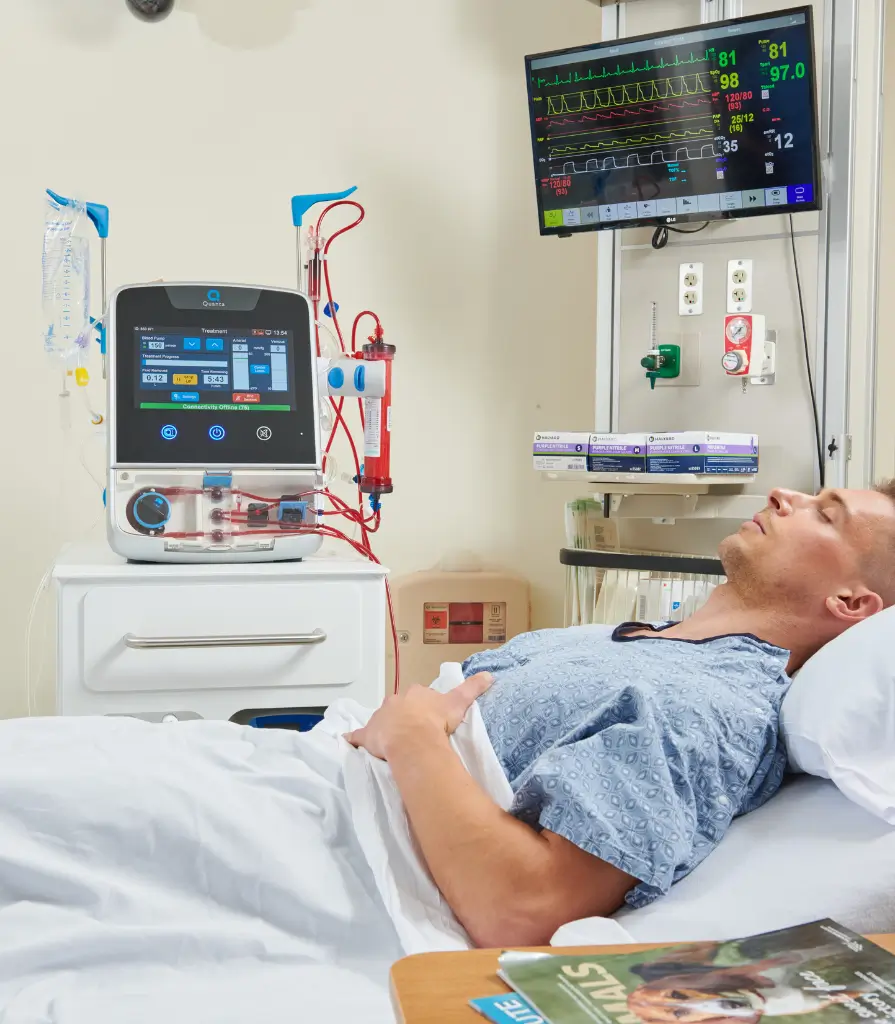
SLED vs. CRRT: Optimizing Acute Kidney Injury Treatment in the ICU
Despite advances in treatment, acute kidney injury (AKI) remains a significant challenge in critical care settings. Sustained Low-Efficiency Dialysis (SLED) and Continuous Renal Replacement Therapy (CRRT) are two primary modalities used in the ICU, but evaluating the best therapeutic approach relies on a variety of factors – from clinical efficacy to operational resources, patient flow optimization, and cost-effectiveness.

SLED vs. CRRT Clinical Outcomes: A Comparative Analysis
When it comes to treatment effectiveness, both SLED and CRRT have been the subject of extensive clinical research. Contemporary meta-analyses of high methodological quality have shown that both options have statistically similar mortality rates at 90 days and one year post-treatment.1 Both modalities exhibit comparable rates of mortality, ICU length of stay, and renal recovery, with no significant difference in the time to renal function restoration.2
Hemodynamic stability is another critical factor in AKI treatment evaluation. SLED has demonstrated comparable tolerability to CRRT in critically ill patients.3 A comprehensive systematic review and network meta-analysis by Xu et al. (2021) further reinforces these findings. The study, which included 30 randomized controlled trials with 3,774 patients, found no significant difference in mortality between CRRT and intermittent hemodialysis (IHD), while SLED was associated with decreased mortality compared to CRRT.4 This analysis provides robust evidence supporting the clinical equivalence of these modalities.
SLED vs. CRRT Operational Benefits: Optimizing Hospital Resources
SLED offers operational advantages that can enhance hospital efficiency, including its flexible treatment schedule. The conversion of a CRRT program to SLED is associated with substantial benefits in term of ICU length of stay, nursing productivity and potentially health outcomes.5
The simplicity of SLED systems can lead to faster staff training and technology adoption. SLED’s versatility allows for real-time prescription adjustments based on patient-specific needs, enabling dynamic transitions between higher and lower dialysate flows during treatment in addition to the ability to more specifically tailor electrolyte composition on the fly as clinical the clinical picture evolves. In contrast, CRRT requires continuous monitoring, more fixed dialysate compositions and dedicated equipment, potentially straining resources in high-demand settings.
As an added benefit, SLED has a decreased risk of being impacted by industry supply shortages or cost fluctuations as dialysate concentrate manufacturers leverage the more diverse supply chain of conventional chronic IHD systems used in the outpatient setting at much higher volumes. CRRT requires the use of sterilized solution bags, which experienced shortages due to a less resilient supply chain during the COVID-19 pandemic and catastrophic weather events. Due to its adaptable design, SLED is less likely to be affected by similar shortages in the future, providing a more reliable treatment alternative for healthcare providers.6
SLED vs. CRRT Cost-Efficiency: A Game-Changer for Healthcare Systems
SLED also presents a cost-effective alternative to traditional CRRT. The use of fewer proprietary consumables, such as solution bags and disposable cassettes, can lead to significant cost savings for health systems. The intermittent nature of SLED can reduce the continuous workload associated with CRRT, potentially decreasing staffing resources and lowering labor costs. Many systems recognize even higher savings depending on factors relating to contract dynamics with outsourced providers, off hours labour premiums and potential use of dedicated critical care nurses to operate SLED equipment at the bedside.
Cost of Care: SLED vs. CRRT
Studies have shown substantial differences in the cost of SLED vs. CRRT treatment,6 representing savings of approximately 45-54%.

Precision Dialysis: Tailoring Treatment to Patient Needs
SLED’s flexibility allows for tailored treatment, offering more options for sodium,potassium, calcium and bicarbonate adjustments compared to the limitations often encountered with pre-made CRRT bags. Clinicians can adjust treatment intensity on-the-fly, transitioning from low to high flow rates as patient conditions change. It’s important to remember that not all patients may be suitable candidates for SLED, and careful assessment is necessary to determine the most appropriate modality.
Ultimately, both SLED and CRRT offer serviceable solutions for AKI treatment in the ICU. SLED stands out for its clinical efficacy, operational benefits, and cost-efficiency, making it an attractive option for healthcare systems seeking to prioritize patient outcomes while optimizing resource utilization. Its flexibility and potential for precision dialysis further enhance its appeal.
Quanta offers innovative dialysis solutions that empower healthcare providers to deliver high-quality care while managing resources effectively. Learn more about SLED treatment options.
References:
- Wald, R., et al. (2020). Short-and long-term outcomes of sustained low efficiency dialysis versus continuous renal replacement therapy in critically ill adults with acute kidney injury: a cohort study. BMC Nephrology, 21(1), 1-10. https://pubmed.ncbi.nlm.nih.gov/33290929/
- Nash, D. M., et al. (2017). The effect of sustained low-efficiency dialysis versus continuous renal replacement therapy on renal recovery after acute kidney injury in the intensive care unit: A systematic review and meta-analysis. Nephrology Dialysis Transplantation, 32(suppl_3), iii54-iii61. https://pubmed.ncbi.nlm.nih.gov/28128881/
- Marshall, M. R., et al. (2017). Sustained low-efficiency daily diafiltration (SLEDD-f) for critically ill patients requiring renal replacement therapy: towards an adequate therapy. Nephrology Dialysis Transplantation, 19(4), 877-884. https://pubmed.ncbi.nlm.nih.gov/15031344/
- Xu, Y., Gao, J., Zheng, X., Zhong, B., Na, Y., & Wei, J. (2021). Comparing Renal Replacement Therapy Modalities in Critically Ill Patients With Acute Kidney Injury: A Systematic Review and Network Meta-Analysis. Critical Care Explorations, 3(6), e0434. https://www.ncbi.nlm.nih.gov/pmc/articles/PMC8162503/
- Nichols, T. G., Doman, D., Mullen, S., Ramaiyah, S., Rowe, S., D’Alessandri-Silva, C. J., & Dunning, S. (2024). Intensive care unit improves dialysis care quality while reducing costs. Journal of medical economics, 27(1), 797–799. https://pubmed.ncbi.nlm.nih.gov/38847361/
- Reddy, S., et al. (2021). Use of sustained low-efficiency dialysis (SLED) for acute kidney injury in COVID-19 patients: A retrospective analysis. Journal of Nephrology, 34(5), 1234-1241. https://pubmed.ncbi.nlm.nih.gov/33611151/
- Berbece, A. N., & Richardson, R. M. (2006). Sustained low-efficiency dialysis in the ICU: cost, anticoagulation, and solute removal. Kidney International, 70(5), 963-968. https://pubmed.ncbi.nlm.nih.gov/16850023/
CLNED-4 v 1.0